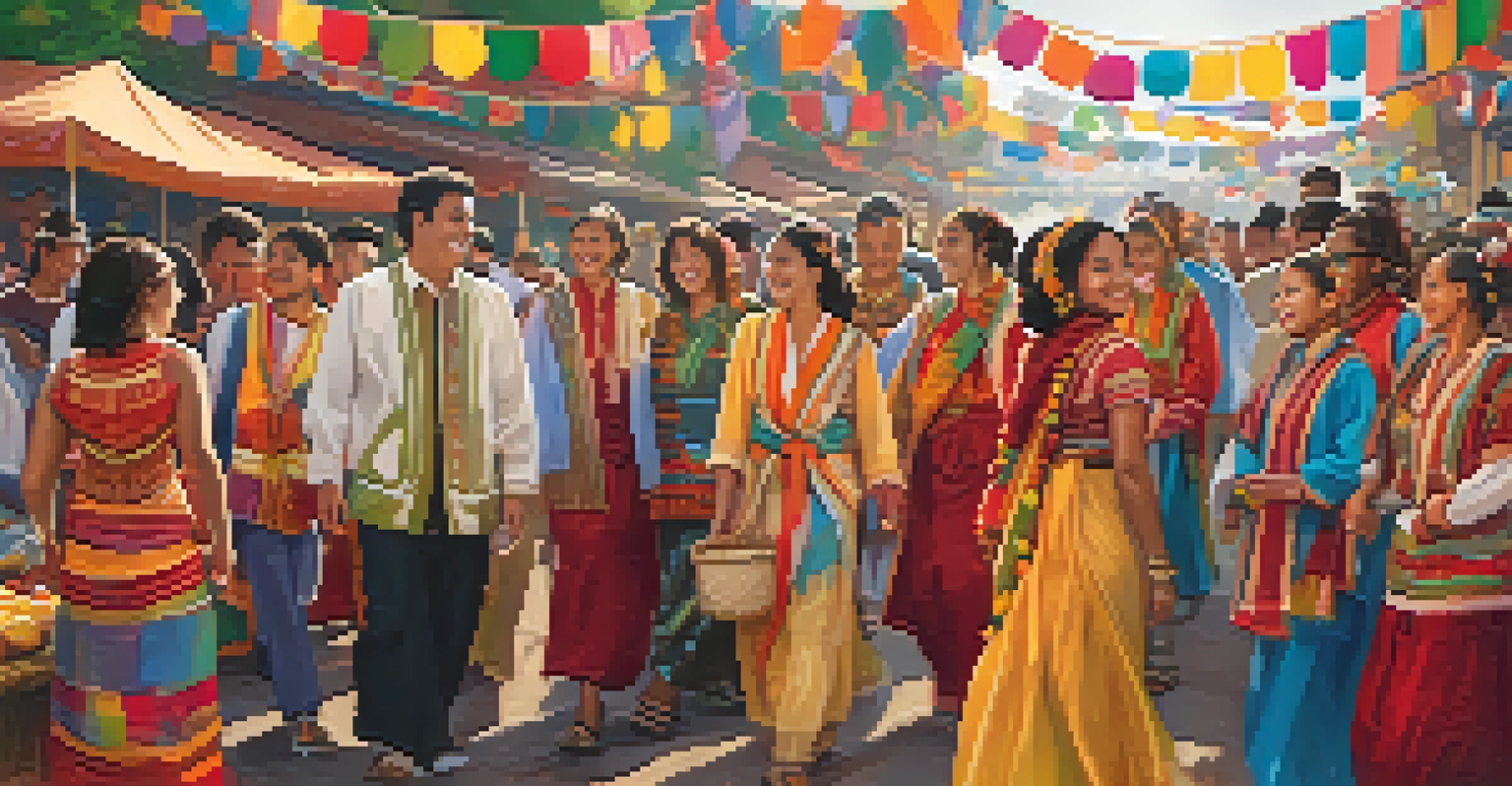Cultural Perspectives: Learning from Diverse Spiritual Traditions

Understanding the Role of Spiritual Traditions in Culture
Spiritual traditions are the backbone of many cultures, shaping values and worldviews. They provide a lens through which communities understand life, death, and the universe. By examining these traditions, we can gain insights into the core beliefs that define different societies.
Spirituality is not a religion, it is a way of life.
For instance, in Hinduism, the concepts of karma and dharma guide ethical behavior, influencing everything from social structures to personal decisions. Meanwhile, Indigenous spiritualities often emphasize a deep connection to nature, teaching respect for the earth and its resources. These examples highlight how spirituality intertwines with cultural identity.
Related Resource
When we appreciate these diverse perspectives, we not only expand our understanding of others but also reflect on our own beliefs and practices. This cultural exchange can inspire dialogue and foster respect among people from varying backgrounds.
Lessons from Eastern Spiritual Practices
Eastern spiritual practices, such as Buddhism and Taoism, offer profound insights into mindfulness and harmony. These traditions encourage individuals to look inward, promoting self-awareness and a sense of peace. By integrating these practices into our daily lives, we can cultivate a more balanced existence.

For example, the practice of meditation in Buddhism teaches us to observe our thoughts without judgment, helping to reduce stress and anxiety. Similarly, Taoism emphasizes living in accordance with the natural flow of life, reminding us to embrace simplicity and spontaneity. These lessons can be transformative, encouraging us to slow down in our fast-paced world.
Spirituality Shapes Cultural Identity
Spiritual traditions influence values and worldviews, helping communities understand their place in the universe.
By adopting elements from these traditions, we can enhance our mental well-being and foster a greater appreciation for the interconnectedness of life. This not only enriches our personal journeys but also encourages a more compassionate society.
The Wisdom of Indigenous Spiritualities
Indigenous spiritual traditions offer unique perspectives on community and the environment. Many Indigenous cultures view themselves as stewards of the land, emphasizing a reciprocal relationship with nature. This worldview promotes sustainability and respect for all living beings.
The earth does not belong to us: we belong to the earth.
For instance, many Native American spiritual practices involve ceremonies that honor the earth and its resources. These rituals remind us of our responsibility to protect the environment and acknowledge the wisdom passed down through generations. Such teachings can inspire modern movements towards ecological awareness and conservation.
Related Resource
By learning from Indigenous spiritualities, we can cultivate a sense of responsibility toward our planet and its inhabitants. This approach encourages us to think beyond ourselves and consider the legacy we leave for future generations.
Exploring Abrahamic Faiths and Their Commonalities
The Abrahamic faiths—Judaism, Christianity, and Islam—share a rich tapestry of beliefs and values. At their core, these religions emphasize the importance of community, compassion, and justice. Understanding their commonalities can bridge gaps and foster interfaith dialogue.
For example, all three traditions teach the significance of helping those in need and promoting social justice. Stories of compassion and charity are prevalent in their sacred texts, encouraging followers to engage with their communities. This shared emphasis on moral action can unite diverse groups in a common cause.
Eastern Practices Promote Mindfulness
Eastern spiritual practices like Buddhism and Taoism encourage self-awareness and peace, enriching personal well-being.
By recognizing these similarities, we can build a foundation for mutual respect and collaboration. Celebrating our shared values allows us to appreciate our differences while working together for a better world.
The Influence of Spirituality on Art and Expression
Spirituality has profoundly shaped art and expression across cultures. From ancient temples to modern installations, religious themes often serve as a source of inspiration for artists. This artistic exploration allows us to appreciate the beauty and depth of various spiritual traditions.
Take, for instance, the intricate designs of Islamic art, which reflect the divine and the infinite. Similarly, the vibrant colors and symbols in Hindu temple art convey complex narratives about deities and their stories. These artistic expressions not only enrich our visual experience but also invite contemplation of deeper spiritual truths.
Related Resource
Engaging with spiritual art encourages us to explore our own beliefs and emotions. It fosters a sense of connection to something greater, reminding us of the shared human experience, regardless of cultural background.
Cultural Festivals: Celebrating Spiritual Diversity
Cultural festivals around the world celebrate spiritual diversity, bringing people together in joyous gatherings. These events offer a glimpse into various traditions, showcasing unique practices, foods, and music. Participating in these festivals can deepen our understanding of different cultures and foster appreciation for diversity.
For example, Diwali, the Hindu festival of lights, symbolizes the victory of light over darkness and good over evil. Similarly, Ramadan, observed by Muslims, emphasizes community, reflection, and gratitude. These celebrations not only reinforce cultural identity but also invite others to partake in the joy and significance of these traditions.
Cultural Festivals Showcase Diversity
Cultural festivals celebrate spiritual diversity, fostering appreciation and unity among different traditions.
By engaging in cultural festivals, we can cultivate a sense of unity amid diversity. These shared experiences create lasting memories and promote a spirit of inclusivity and open-mindedness.
The Future of Spirituality in a Globalized World
In our increasingly globalized world, spirituality is evolving and blending across cultures. As people migrate and interact, spiritual practices are shared and adapted, creating rich hybrid traditions. This evolution reflects the dynamic nature of spirituality in our interconnected society.
For instance, yoga, rooted in ancient Indian philosophy, has gained immense popularity worldwide, often incorporating elements from various cultures. Similarly, spiritual practices like mindfulness have transcended their origins to become mainstream wellness trends. This cross-pollination enriches our understanding of spirituality and fosters dialogue among diverse beliefs.

As we move forward, embracing this evolution can lead to greater understanding and collaboration. By appreciating the diverse spiritual landscapes, we can create a more harmonious world where different traditions coexist and thrive.